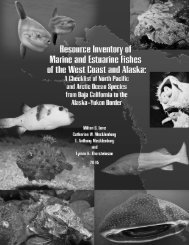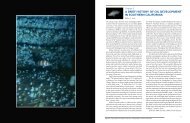Reproductive Ecology and Body Burden of Resident ... - The Love Lab
Reproductive Ecology and Body Burden of Resident ... - The Love Lab
Reproductive Ecology and Body Burden of Resident ... - The Love Lab
You also want an ePaper? Increase the reach of your titles
YUMPU automatically turns print PDFs into web optimized ePapers that Google loves.
Discussion<br />
Results from univariate two-factor analysis <strong>of</strong> variance <strong>and</strong> multivariate canonical discriminant analysis<br />
indicate that the elemental composition <strong>of</strong> otoliths differ between the two habitat types—the sampled<br />
platforms <strong>and</strong> natural sites—<strong>and</strong> geographic areas, although there were significant interaction effects (habitat<br />
x area) on single element abundances in otoliths. Kelp rockfish collected from platforms tended to incorporate<br />
higher concentrations <strong>of</strong> Mg <strong>and</strong> Ba <strong>and</strong> lower concentration <strong>of</strong> Sr in otoliths compared to fish<br />
from natural habitat. In comparison, Pacific s<strong>and</strong>dab collected from platforms tended to have lower concentrations<br />
<strong>of</strong> Ba <strong>and</strong> Fe in otoliths compared to fish from natural habitat. Sr Ca -1 in otoliths <strong>of</strong> kelp rockfish<br />
tended to decrease eastward along the coastal shelf from Point Conception through the east Channel. Mn<br />
Ca -1 in otoliths <strong>of</strong> s<strong>and</strong>dab from both habitat types was lower in the three westernmost geographic areas<br />
(Point Conception, west Santa Barbara, <strong>and</strong> east Santa Barbara) than in the eastern <strong>and</strong> southern areas (east<br />
channel mainl<strong>and</strong> shelf, <strong>of</strong>fshore east channel, <strong>and</strong> Southern California Bight). Mn Ca -1 was not detectable<br />
in kelp rockfish otoliths. Variability in otolith element concentrations between habitat types <strong>and</strong> among<br />
areas differed between the two species.<br />
<strong>The</strong> success rate <strong>of</strong> correctly assigning fish to habitat type (platform or natural habitat) using canonical<br />
discriminant functions based on otolith element signatures differed between species. Cross-validation <strong>of</strong><br />
the discriminant function showed a very high proportion, 94%, <strong>of</strong> kelp rockfish individuals were correctly<br />
assigned to habitat type based on the otolith signature <strong>of</strong> Mg Ca -1 , Ba Ca -1 , <strong>and</strong> Sr Ca -1 . A lower proportion,<br />
64%, <strong>of</strong> Pacific s<strong>and</strong>dab correctly grouped into habitat type based on the otolith signature <strong>of</strong> Mg Ca -1 , Sr Ca -1 ,<br />
Mn Ca -1 , Cu Ca -1 , <strong>and</strong> Ba Ca -1 —otolith element concentrations that individually varied between s<strong>and</strong>dab<br />
habitat types <strong>and</strong>/or areas.<br />
<strong>The</strong> usefulness <strong>of</strong> otolith chemical tags relies on detectable differences between habitats <strong>of</strong> interest,<br />
such as platforms <strong>and</strong> natural areas that are spatially <strong>and</strong> temporally consistent (Campana et al. 2000). We<br />
observed adequate spatial consistency <strong>of</strong> the kelp rockfish otolith multi-element signatures to discriminate<br />
platforms from natural sites across areas characterized by different water masses <strong>and</strong> currents (Nishimoto<br />
<strong>and</strong> Washburn 2002, Nishimoto 2009). Uncertainty in the spatial consistency <strong>of</strong> platform <strong>and</strong> natural habitat<br />
differences beyond our sampling <strong>of</strong> five platforms <strong>and</strong> five natural areas could be reduced by examining<br />
the otolith microchemistry <strong>of</strong> fish from a broader sampling <strong>of</strong> the 23 platforms in the Pacific Outer Continental<br />
Shelf region where kelp rockfish reside as juveniles, for example, <strong>and</strong> natural areas that fish might<br />
utilize later during their life history.<br />
In comparison with our findings, a “platform fingerprint” in otoliths from the Gulf <strong>of</strong> Mexico was<br />
identified by Nowling et al. (2005). <strong>The</strong>y investigated the concentration <strong>of</strong> 15 isotopes <strong>of</strong> the heavy metals,<br />
V, Co, Ni, Zn, Cu, Ag, Cd, Pb, <strong>and</strong> U, in whole otoliths <strong>of</strong> the red snapper (Lutjanus campechanus) from platforms<br />
<strong>and</strong> artificial reefs <strong>of</strong>f Louisiana <strong>and</strong> artificial reefs <strong>of</strong>f Alabama. <strong>The</strong> isotopes were identified as products<br />
<strong>of</strong> historic drilling activities <strong>and</strong> natural weathering processes <strong>of</strong> the platform structure <strong>and</strong> typically<br />
are not analyzed in otolith microchemistry. Ba was not included in the assay panel. Isotopes <strong>of</strong> V, Zn, Ag,<br />
U, <strong>and</strong> Pb were found to be good discriminators between platforms <strong>and</strong> reefs. Concentrations <strong>of</strong> 51 V, 107 Ag,<br />
109<br />
Ag, 206 Pb, 207 Pb, <strong>and</strong> 208 Pb were higher <strong>and</strong> 64 Zn <strong>and</strong> 66 Zn were lower in fish otoliths from platforms than<br />
from Louisiana or Alabama artificial reefs. U was higher at platforms <strong>and</strong> artificial reefs in Louisiana than<br />
artificial reefs in Alabama. <strong>The</strong> elements assayed using solution-based ICP-MS in the Nowling et al (2005)<br />
study were either below detection limits or undetectable using LA ICP-MS in this study.<br />
Different combinations <strong>of</strong> the elements in otoliths that we examined were useful discriminators <strong>of</strong><br />
habitat type <strong>and</strong> geographic areas in other studies <strong>of</strong> rockfishes <strong>of</strong> the California Current region. Warner et<br />
al. (2005) found that the concentrations <strong>of</strong> Sr <strong>and</strong> Ba from the outermost growth layer <strong>of</strong> adult kelp rockfish<br />
differed <strong>and</strong> Mg concentrations did not differ among mainl<strong>and</strong> <strong>and</strong> isl<strong>and</strong> sites in the Santa Barbara<br />
59




